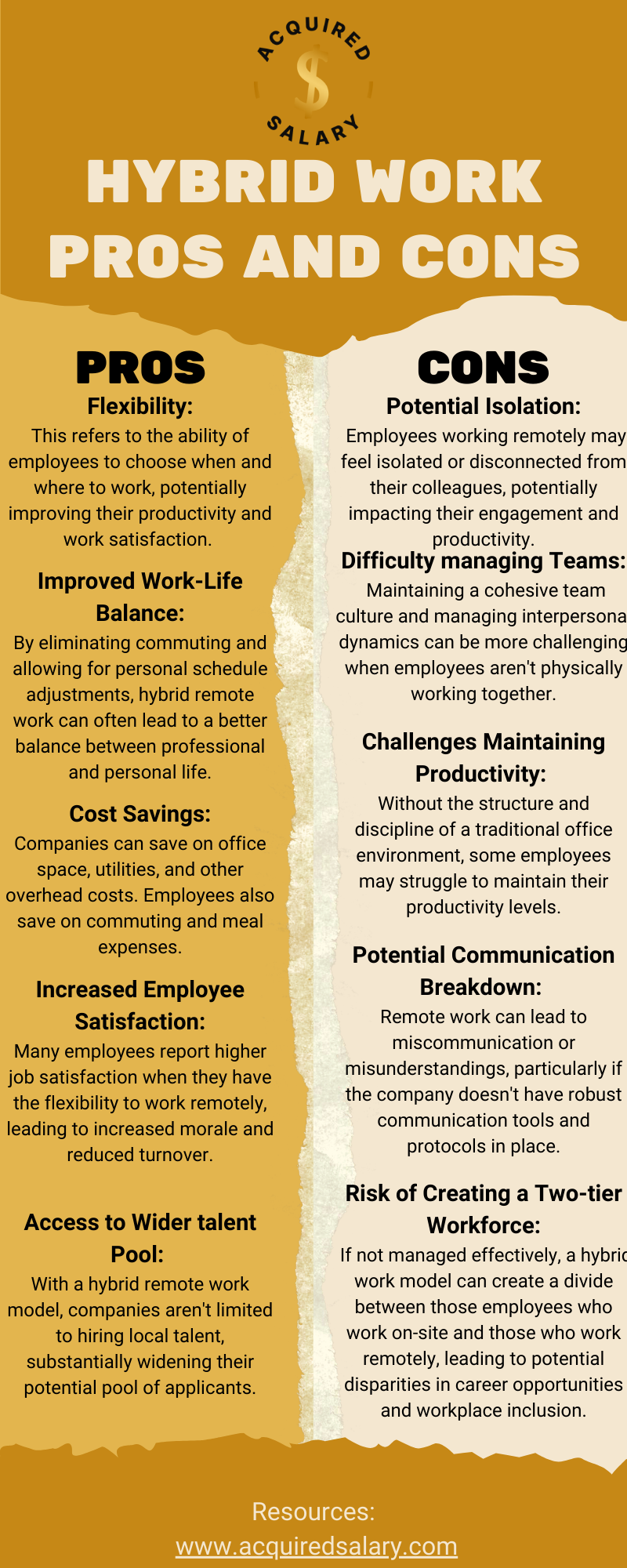Unraveling Hybrid Remote Work: A Comprehensive Guide
Hybrid remote work, or simply hybrid work, is a relatively new term that has emerged in the world of work, particularly brought into the spotlight by the COVID-19 pandemic. Understanding the hybrid remote meaning is critical for both employers and employees as they navigate the ever-evolving landscape of work, which many believe to be the future of remote work. This guide aims to provide a comprehensive look into hybrid remote work and its potential benefits and challenges.
So, what is hybrid work? Hybrid remote work is an employment model that combines traditional on-site work and remote work, hence the hybrid meaning in job. This hybrid job model allows employees to alternate between working from their homes (or any other location) and a company's physical office. The frequency of this alternation can vary widely depending on the company's policies and the nature of the job.
The Emergence of Hybrid Remote Work
Hybrid remote work, a trending topic among remote working trends, has been around in various forms since the 1970s and has evolved due to changes in technology, government policies, and societal norms. However, its popularity has surged in recent years due to the rise of digital technology and the changes brought about by the pandemic.
The Appeal of Hybrid Remote Work
The hybrid remote work model can be very attractive to employees for several reasons. It offers work flexibility, a key aspect of hybrid work, and flexibility, allowing employees to balance their personal and professional lives more effectively. It can also provide an optimal work environment by enabling employees to work in an environment where they feel most productive, whether that's at home or in the office.
The Various Forms of Hybrid Remote Work
Hybrid remote work, one of the popular hybrid workplace models, comes in different forms, each with its own set of policies and expectations. Here are a few common types:
- Office-First: Employees are primarily expected to work in the office but are given the flexibility to work remotely on certain days.
- Flexible Hybrid: Employees are given the freedom to choose when and where they work, with no strict rules on the number of office days.
- Remote-Friendly: The company has a strong focus on remote work, but offices are available for those who prefer an in-office environment.
- Remote-First: The company operates entirely remotely, with no physical office.
Differences between Remote and Hybrid Work
While both remote and hybrid work models allow employees, or remote employees, to work outside the traditional office setting, there are key differences. In a fully remote job setting, all employees work from their chosen location at all times. In contrast, a hybrid model involves a combination of on-site and off-site work.
Key Considerations for Transitioning to Hybrid Remote Work
Transitioning to a hybrid remote work model, or simply a hybrid work model, requires careful planning and consideration. Companies must consider the documentation and talent acquisition aspects of this transition. nature of the work, the preferences of employees, and their organizational culture. They should also establish clear communication channels and workplace policies to ensure a smooth transition.
The Role of Space and Time in Hybrid Models
In a hybrid work model, both the physical workspace, or hybrid office, and the work schedule play crucial roles. Employers must create an inclusive office space that caters to both on-site and remote workers. Furthermore, flexible work schedules are crucial to accommodate the varied needs and preferences of employees.
Creating a Network of Spaces for Hybrid Work
To facilitate hybrid work, companies, especially remote companies, can create a network of workspaces. This could include traditional offices, coworking spaces, and home offices. By offering a variety of workspaces, companies can cater to the diverse needs of their remote employees and foster a more inclusive work environment.
Learning from Companies Transitioning to Hybrid Remote Work
Several companies have successfully transitioned to hybrid remote work, paving the way for the future of the office. By studying their strategies and practices, other companies can gain valuable insights and learn effective strategies for managing a remote workforce.
Benefits and Challenges of Hybrid Remote Work
Hybrid remote work, or 'hybrid work', provides numerous benefits such as increased flexibility, improved work-life balance, potential cost savings, and enhanced employee engagement. However, it also poses challenges like managing team dynamics, establishing effective communication channels, and maintaining team performance, especially with remote employees.
Tips for Managing a Hybrid Remote Team
Effective management, particularly remote management, is crucial for a successful hybrid remote team. Managers should set clear expectations, create a performance management plan for the transition, adapt to diverse meeting types, prepare for potential hiccups, and choose the right technology to support the team.
Starting Your Journey with Hybrid Remote Work
Embracing hybrid work can be a rewarding journey for both employers and employees. By understanding the nuances of this work model, you can create a work environment that fosters productivity, collaboration, career development, and work-life balance, enhancing the overall employee experience.
As you navigate this new world of hybrid work, remember that work flexibility, communication, and inclusivity are key. Whether you're an employer looking to transition your team to a hybrid model, or an employee seeking a more flexible work arrangement, hybrid remote work offers a promising path forward, fostering a strong remote culture.
Hybrid work offers the best of both worlds: the flexibility of remote work and the social interaction of traditional office work.
Final Thoughts
In conclusion, hybrid work offers a promising solution to the evolving needs of the modern workforce, shaping the future of office work. It combines the benefits of both on-site and remote work, providing a flexible and inclusive work environment for remote employees. However, it's not without its challenges. Companies need to carefully plan their transition to a hybrid model, considering the needs of their employees, the nature of the work, and their organizational culture. With thoughtful planning and effective management, companies can reap the benefits of a hybrid remote work model and create a future-ready workplace.

In the journey to implement a successful hybrid work model, remember that each organization is unique. What works well for one may not necessarily work for another. The key is to remain flexible, listen to your employees, and continually adapt to changing circumstances, fostering employee engagement and career development.
Start your journey to hybrid work today and unlock the potential of a flexible, diverse, and engaged workforce, shaping the future of the office.
Note: The statistics and insights mentioned in this article are based on extensive research and real-life case studies. However, they should be used as a guide and not taken as definitive advice. Always consult with a professional before making any major decisions related to your organization's work model.
Career Mastery Community

How to get a promotion in less than 90 days and learn the 3 pillars to increase your Salary by 30% or more.
Ready to take your career to the next level?
Learn even more about successfully developing your career without going back to school. Click the button to join Acquired Salary's Career Mastery Mastermind!
More Career Tips, Tricks & Tools
Blog




-
What do career coaches do?
Career coaches assess skills and values to align them with suitable career paths. They offer strategic advice on job search activities, including crafting compelling resumes and cover letters. Career coaches can also assist with overcoming workplace challenges and fostering professional development.
-
How do I know if I need a career coach?
If you find yourself feeling stuck, unfulfilled, or uncertain about your career path, a career coach can provide valuable insights and strategies to help you make informed decisions. Whether you're considering a career change, seeking professional growth, or looking to improve your job search techniques, a career coach can be a valuable partner in your journey to success.
-
How long does career coaching take?
The duration of career coaching varies depending on your unique circumstances and objectives. Some clients find value in a few focused sessions, while others choose ongoing support over an extended period. Your career coach will work with you to determine the most suitable timeframe and frequency of sessions to ensure maximum benefit.
-
Why Salary is better than hourly?
There are benefits to both salary and hourly. The benefits of having a salary is the security of steady paychecks and on average salary employees tend to have a higher income than hourly employees.
-
Why is salary Important
When you have employees who are getting paid salary they are usually more productive if they are paid right. That is why salary negotiations are much more important. A salary increase plays a crucial role in productivity.
-
How to negotiate salary?
When negotiating salary there are mutliple ways you can be productive. These can include: becoming familiar with your industry, staying positive, practice, and more.
Subscribe to Our Newsletter
We will get back to you as soon as possible
Please try again later